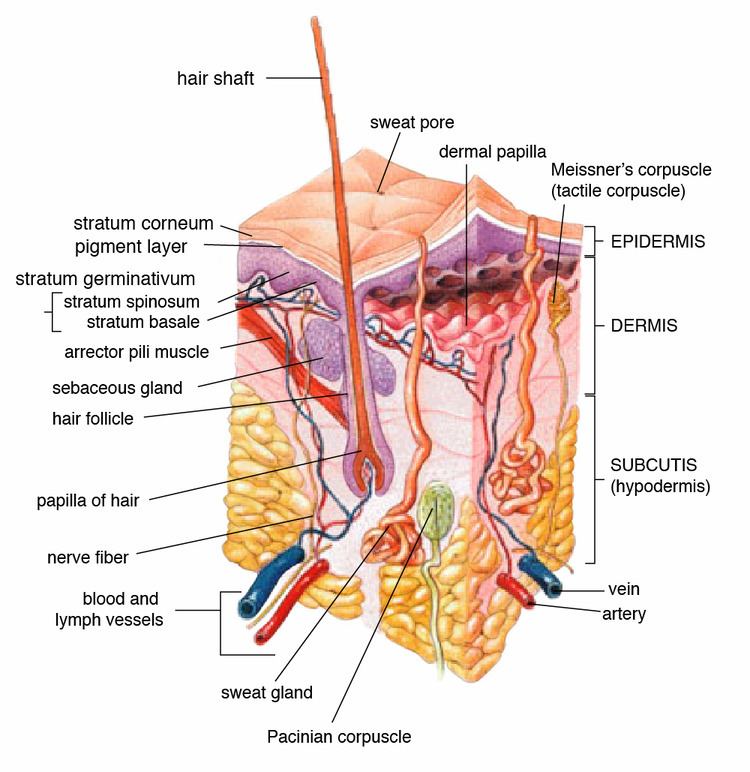System integumentary MeSH A10.165.887 TA A16.0.03.001 | Latin tela subcutanea Code TH H3.12.00.2.00001 | |
 | ||
Artery Posterior intercostal arteries | ||
The subcutaneous tissue (from Latin subcutaneous, meaning 'beneath the skin'), also called the hypodermis, hypoderm (from Greek, meaning 'beneath the skin'), subcutis, or superficial fascia, is the lowermost layer of the integumentary system in vertebrates. The types of cells found in the hypodermis are fibroblasts, adipose cells, and macrophages. The hypodermis is derived from the mesoderm, but unlike the dermis, it is not derived from the dermatome region of the mesoderm. In arthropods, the hypodermis is an epidermal layer of cells that secretes the chitinous cuticle. The term also refers to a layer of cells lying immediately below the epidermis of plants.
Contents
The hypodermis is beneath dermis which is beneath epidermis. It is used mainly for fat storage.
A layer of tissue lies immediately below the dermis of vertebrate skin. It is often referred to as subcutaneous tissue though this is a less precise and anatomically inaccurate term. The hypodermis consists primarily of loose connective tissue and lobules of fat. It contains larger blood vessels and nerves than those found in the dermis.
Composition
Subcutaneous tissue consists of:
In some animals, such as whales and hibernating mammals, the hypodermis forms an important insulating layer and/or food store.
In some plants, the hypodermis is a layer of cells immediately below the epidermis of leaves. It is often mechanically strengthened, for example, in pine leaves, forming an extra protective layer or a water storage tissue.
Subcutaneous fat
Subcutaneous fat is the layer of subcutaneous tissue that is most widely distributed. It is composed of adipocytes, which are grouped together in lobules separated by connective tissue. The number of adipocytes varies among different areas of the body, while their size varies according to the body's nutritional state. It acts as padding and as an energy reserve, as well as providing some minor thermoregulation via insulation. Subcutaneous fat is found just beneath the skin, as opposed to visceral fat, which is found in the peritoneal cavity, and can be measured using body fat calipers to give a rough estimate of total body adiposity. It is thickest in the buttocks, palms, and soles.
Injection
Injection into the subcutaneous tissue is a route of administration used for drugs such as insulin: because it is highly vascular, the tissue absorbs drugs quickly. Subcutaneous injection is believed to be the most effective manner to administer some drugs, such as human growth hormones. Just as the subcutaneous tissue can store fat, it can also provide good storage space for drugs that need to be released gradually because there is limited blood flow. "Skin popping" is a slang term that includes this method of administration, and is usually used in association with recreational drugs.
